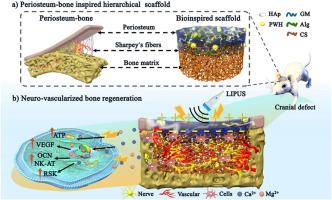Periosteum-bone inspired hierarchical scaffold with endogenous piezoelectricity for neuro-vascularized bone regeneration
IF 18
1区 医学
Q1 ENGINEERING, BIOMEDICAL
引用次数: 0
Abstract
The development of scaffolds for repairing critical-sized bone defects heavily relies on establishing a neuro-vascularized network for proper penetration of nerves and blood vessels. Despite significant advancements in using artificial bone-like scaffolds infused with various agents, challenges remain. Natural bone tissue consists of a porous bone matrix surrounded by a neuro-vascularized periosteum, with unique piezoelectric properties essential for bone growth. Drawing inspiration from this assembly, we developed a periosteum-bone-mimicking bilayer scaffold with piezoelectric properties for regeneration of critical-sized bone defects. The periosteum-like layer of this scaffold features a double network hydrogel composed of chelated alginate, gelatin methacrylate, and sintered whitlockite nanoparticles, emulating the viscoelastic and piezoelectric properties of the natural periosteum. The bone-like layer is composed of a porous structure of chitosan and bioactive hydroxyapatite created through a biomineralization process. Unlike conventional bone-like scaffolds, this bioinspired bilayer scaffold significantly enhances osteogenesis, angiogenesis, and neurogenesis combined with low-intensity pulsed ultrasound-assisted piezoelectric stimulation. Such a scheme enhances neuro-vascularized bone regeneration in vivo. The results suggest that the bilayer scaffold could serve as an effective self-powered electrical stimulator to expedite bone regeneration under dynamic physical stimulation.

用于神经血管骨再生的具有内生压电性的骨膜-骨启发分层支架
用于修复临界大小骨缺损的支架的开发在很大程度上依赖于神经血管网络的建立,以实现神经和血管的适当穿透。尽管在使用注入各种药剂的人工骨支架方面取得了重大进展,但挑战依然存在。天然骨组织由多孔骨基质和神经血管化的骨膜组成,具有骨生长所必需的独特压电特性。我们从这一组合中汲取灵感,开发出一种具有压电特性的骨膜-骨模拟双层支架,用于临界大小骨缺损的再生。这种支架的类骨膜层是由螯合海藻酸盐、甲基丙烯酸明胶和烧结白锁石纳米颗粒组成的双层网络水凝胶,模拟了天然骨膜的粘弹性和压电特性。类骨层由壳聚糖多孔结构和通过生物矿化过程产生的生物活性羟基磷灰石组成。与传统的类骨支架不同,这种生物启发双层支架与低强度脉冲超声辅助压电刺激相结合,能显著增强骨生成、血管生成和神经发生。这种方案增强了体内神经血管化骨再生。研究结果表明,双层支架可作为一种有效的自供电电刺激器,在动态物理刺激下加速骨再生。
本文章由计算机程序翻译,如有差异,请以英文原文为准。
求助全文
约1分钟内获得全文
求助全文
来源期刊

Bioactive Materials
Biochemistry, Genetics and Molecular Biology-Biotechnology
CiteScore
28.00
自引率
6.30%
发文量
436
审稿时长
20 days
期刊介绍:
Bioactive Materials is a peer-reviewed research publication that focuses on advancements in bioactive materials. The journal accepts research papers, reviews, and rapid communications in the field of next-generation biomaterials that interact with cells, tissues, and organs in various living organisms.
The primary goal of Bioactive Materials is to promote the science and engineering of biomaterials that exhibit adaptiveness to the biological environment. These materials are specifically designed to stimulate or direct appropriate cell and tissue responses or regulate interactions with microorganisms.
The journal covers a wide range of bioactive materials, including those that are engineered or designed in terms of their physical form (e.g. particulate, fiber), topology (e.g. porosity, surface roughness), or dimensions (ranging from macro to nano-scales). Contributions are sought from the following categories of bioactive materials:
Bioactive metals and alloys
Bioactive inorganics: ceramics, glasses, and carbon-based materials
Bioactive polymers and gels
Bioactive materials derived from natural sources
Bioactive composites
These materials find applications in human and veterinary medicine, such as implants, tissue engineering scaffolds, cell/drug/gene carriers, as well as imaging and sensing devices.
 求助内容:
求助内容: 应助结果提醒方式:
应助结果提醒方式:


